Global Warming IS Something to Sneeze At!
Yes, global warming is making people suffer increased allergic reactions and asthma attacks. This post will summarize why some people have allergies and asthma and why global warming is making these illnesses worse for them.
Allergies:
Allergies are the immune system’s response to normally harmless substances that it can’t tolerate. The two short videos below from About.com: Allergies show how allergens affect the body:
 All about allergies (1:26) |
 Do you suffer from hay fever? (1:29) |
According to the American Academy of Allergy Asthma & Immunology:
Your immune system controls how your body defends itself. For instance, if you have an allergy to pollen, your immune system identifies pollen as an invader or allergen. Your immune system overreacts by producing antibodies called Immunoglobulin E (IgE). These antibodies travel to cells that release chemicals, causing an allergic reaction. This reaction usually causes symptoms in the nose, lungs, throat, sinuses, ears, lining of the stomach or on the skin.
Each type of IgE has specific “radar” for each type of allergen. That’s why some people are only allergic to cat dander (they only have the IgE antibodies specific to cat dander); while others have allergic reactions to multiple allergens because they have many more types of IgE antibodies.
It is not yet fully understood why some substances trigger allergies and others do not, nor why some people have allergic reactions while others do not. A family history of allergies is the single most important factor that puts you at risk of developing allergic disease.
I am highly allergic to tree pollen, especially oak. (I am also quite allergic to cats.) The image below from The Weather Channel shows why people like me in New York who are allergic to tree pollen had a rough April. Tree pollen peaks in May so May is not going to be much fun either.
The National Allergy Bureau has pollen and mold counting stations across the country. To view the pollen and mold levels for your area, visit their interactive map.
Asthma:
According to the American Academy of Allergy Asthma & Immunology:
Asthma is a chronic lung disease characterized by coughing, chest tightness, shortness of breath and wheezing. Up to 78% of those with asthma also have allergic rhinitis. The role of allergy in asthma is greater in children than in adults.
When you experience asthma symptoms, your inflamed airways become narrowed, making it more difficult to breathe. If you have allergies, inhaling allergens may cause increased swelling of your airway lining and further narrowing of your air passages. Asthma may also occur as a result of respiratory tract infections or exposure to irritants like tobacco smoke.
The video below illustrates what happens in an asthma attack:
I also recommend eMedicineHealth.com’s slideshow titled: Asthma – An Inflammatory Disorder of the Airways to learn more about Asthma.
Allergy Remedies:
According to Medicine.net:
Avoidance of identified allergens is the most helpful factor in controlling allergy symptoms. Attempts to control the environment and avoidance measures often significantly aid in resolving symptoms. However, allergy avoidance is often not easy.
If avoidance is not possible or does not relieve symptoms, additional treatment is needed. Many patients respond to medications that combat the effects of histamine, known as antihistamines. Antihistamines do not stop the formation of histamine, nor do they stop the conflict between the IgE and antigen. Therefore, antihistamines do not stop the allergic reaction but rather protect tissues from the effects of the allergic response.
The first-generation antihistamines, such as diphenhydramine (Benadryl), chlorpheniramine (Chlortrimaton), dimenhydrinate (Dramamine), brompheniramine (Dimetapp and others), clemastine fumarate (Tavist, Allerhist), and dexbrompheniramine (Drixoral) frequently cause mouth dryness and sleepiness. Newer, so-called “non-sedating” or second-generation antihistamines are also available. These include loratadine (Claritin), fexofenadine (Allegra), cetirizine (Zyrtec), fexofenidine (Allegra), and azelastine (Astelin Nasal Spray). In general, this group of antihistamines is more expensive, has a slower onset of action, is longer acting, and induces less sleepiness.
Decongestants help control allergy symptoms but not their causes. Decongestants shrink the swollen membranes in the nose and make it easier to breathe. Decongestants can be taken orally or by nasal spray. Decongestant nasal sprays should not be used for more than five days without a doctor’s advice, and if so, usually only when accompanied by a nasal steroid. Decongestant nasal sprays often cause a so-called “rebound effect” if taken for too long. A rebound effect is the worsening of symptoms when a drug is discontinued. This is a result of a tissue dependence on the medication.
According to Discovery Health:
Antihistamines work by blocking the effects of histamine, the chemical responsible for many of the allergy symptoms you experience. When histamine is released, it binds to special sites called receptors on cells in your nose and throat, causing them to swell and leak fluid. This results in inflammation, nasal congestion, runny nose, sneezing, itching, and other symptoms.
Antihistamines block the effects of histamine by “coating” receptors, which prevents binding. This, in turn, prevents nasal allergy symptoms. Histamine works quickly once released. By the time your symptoms appear, the histamine has already attached to cell receptors, and the allergic reaction is well under way. That’s why you need to take antihistamines 2 to 5 hours before exposure to allergens. Or you need to take them on a regular basis.
Some antihistamines go to work 15 to 30 minutes after they’re taken. They reach their peak effectiveness in 1 to 2 hours. If you take an antihistamine before you’re exposed to your allergens, the allergic reaction can be stopped.
I can vouch for that. I find that if I do not get meds into my system BEFORE I have an allergic reaction, I am pretty much miserable for the rest of that day.
Asthma Remedies:
The Mayo Clinic has a very good summary of asthma treatment. A short summary appears below:
Treating asthma involves both preventing symptoms and treating an asthma attack in progress. Preventive, long-term control medications (inhaled corticosteroids, Leukotriene modifiers, Theophylline, Long-acting beta agonists (LABAs), Combination inhalers) reduce the inflammation in your airways that leads to symptoms. Quick-relief (rescue) medications (short-acting beta agonists, Ipratropium [Atrovent], oral and intravenous corticosteroids) quickly open swollen airways that are limiting breathing. Most people with persistent asthma use a combination of long-term control medications and quick-relief medications, taken with a hand-held inhaler.
Climate Change and Allergies:
After that record warm week in early April, I began researching the topic and came up with a few good papers, some of which will be referenced below, but the National Wildlife Federation (NWF) scooped me! About the middle of April, the NWF released a document titled Extreme Allergies and Global Warming that is an exhaustive study on how global warming is exacerbating allergies and asthma symptoms.
All information below comes from this document unless noted otherwise.
- Global warming will worsen allergies for approximately 25 million Americans.
- Ragweed, the main cause of fall allergies, grows faster, produces more pollen, and has a higher allergenic content under increased carbon dioxide levels.
- Longer growing seasons under a warmer climate produce larger ragweed plants that produce more pollen later into the fall.
- Springtime allergies to tree pollen could also get worse.
- Warmer climates will allow oaks and hickories, two of the most allergenic trees, to expand their habitats northward.
- Climate change may also increase the amount of fungal allergens in the air.
Ragweed is the cause for about 75% of those that suffer from “hay fever”. Each plant can produce about one billion grains of pollen each that can be carried by wind up to 400 miles. Pollen production is projected to increase by 60 to 100 percent by the year 2085 from the increasing CO2 in the atmosphere.
Ragweed may become more allergenic. Amb a1, the allergenic protein in ragweed, increased by 70 percent when CO2 levels were increased from today’s values (385 ppm) to 600 ppm.
Global warming is causing spring to arrive earlier. Satellites have measured the arrival of spring between 10 to 14 days earlier than 20 years ago. One study showed that if spring arrives 30 days earlier, there will be a 55 percent increase in ragweed pollen production.
My nemesis, tree pollen, will also become worse in a warmer climate. With warmer conditions, oak and hickory (highly allergenic) will move northward and push out less allergenic species such as pine, spruce, and firs. These shifts will most dramatic along the Appalachian Mountains, the Northeast from Pennsylvania to Maine, the Upper Midwest, and along the lower Mississippi.
Fungal spores, which can cause allergic and asthmatic reactions could also become more prevalent in a warmer climate. One study showed that doubling CO2 levels from today’s values will increase airborne fungal spores released by leaf litter (dead plant material, such as leaves, bark, and twigs) four-fold. Heavy rainfall and flooding events, all predicted to increase in a warmer climate, proliferate indoor fungal spores. After Hurricane Katrina, for example, mold problems were widespread and hospitals in New Orleans reported a large increase in patients with allergy symptoms, coughs, and childhood asthma.
Climate Change and Asthma:
The World Health Organization estimates that globally 300 million people currently have asthma, and 250,000
people die from asthma each year. In the US, 20 million people (6.2 million children under 18 and 13.8 million adults) have active asthma. (Shea et al., 2008) The National Institute of Environmental Health (NIEH) in their April 2010 report, A Human Health Perspective On Climate Change, state that asthma is the second leading cause of chronic illness among children and is rapidly rising among children less than five years old.
About 10 million Americans suffer from “allergic asthma” – asthma attacks that are triggered by allergens. As allergens increase, so do episodes of asthma. Global warming may exacerbate air pollution that interacts with allergens to trigger more severe asthma attacks. The potential impact of global warming may have a significant economic impact. Allergies and asthma already cost the U.S. more than $32 billion per year in direct health care costs and lost worker productivity.
Thunderstorms are projected to increase with increased global warming. According to a review of the literature, D’Amato and Cecchi (2008) find that thunderstorms induce dramatic allergic asthma attacks summarized below:
- The occurrence of epidemics is closely linked to thunderstorms
- The thunderstorm-related epidemics are limited to late spring and summer when there are high levels of airborne pollen grains
- There is a close temporal association between the arrival of the thunderstorm, a major rise in the concentration of pollen grains and the onset of epidemics
- Subjects with pollen allergy who stay indoors with windows closed during thunderstorms are not involved
- During epidemics there are not high levels of gaseous and particulate components of air pollution
- There is a major risk for subjects who are not under anti-asthma correct treatment
- Subjects with allergic rhinitis and without previous asthma can experience severe bronchoconstriction
Ozone, particle pollution, and other forms of air pollution worsen asthma and increase hospital visits for people with asthma. Children with asthma are especially vulnerable to these effects. Tropospheric (low level) ozone forms when there is bright sunshine and high temperatures that cause volatile organic compounds (VOCs) and nitrogen oxides to react with each other. D’Amato and Cecchi find that tropospheric ozone is increasing in most regions and is expected to continue over the next 50 years or more. The authors conclude that climate change appears to induce an increased concentration of all health-related air pollutants, except SO2.
Bell, et al. (2007) modeled ozone pollution vs. increased temperatures (with constant GHG emissions) through the year 2050 in 50 US cities and found a 2.1 percent increase in asthma hospitalizations across all cities, with the largest cities increasing rates to 4.7% from ozone exposure alone. Bell et al. also note that at least 48% of US residents live in EPA ozone 8-hour nonattainment areas and ground-level ozone is increasing in most regions of the world.
As heat waves and droughts increase, the threat of wildfires also increases. Wildfire smoke produces large amounts of CO, CO2, NOx, ozone, particulate matter (PM), and VOCs. Wildfires that occur near human settlements, also contain traces of plastics, pesticides, herbicides, and fungicides. Epidemiological studies have shown that there is a short-term increase in cardiorespiratory hospitalizations caused by exposure to wildfires.
In addition, drought, declining water quality, and warmer temperatures contribute to the growth of harmful algal blooms that produce toxins that become airborne and exacerbate asthma and respiratory disease. (NIEH, 2010)
One positive note is that a warmer climate is likely to reduce the effects of cold air on asthma and rhinitis and perhaps make patients less susceptible to upper respiratory infections. Bell, et al. (2007)
The image below shows the worst cities in the United States for asthmatics and for spring and fall allergies. Are any of these near you?
When I began researching this topic, I was more focused on climate change and its effect on allergies. I do not have asthma so it never occurred to me that climate change is a far greater concern for asthmatics.
Climate change is more than just something to sneeze at – it can be deadly for asthmatics!
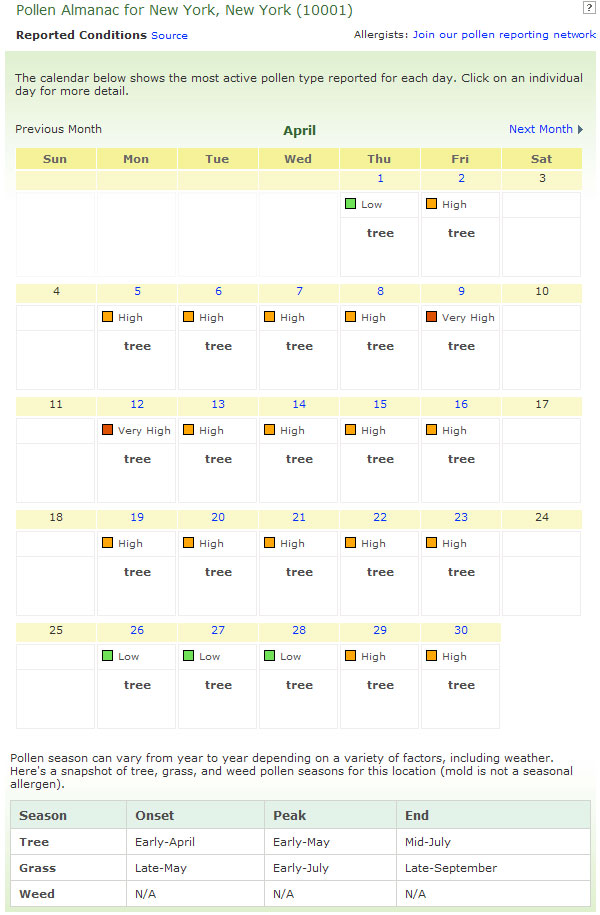
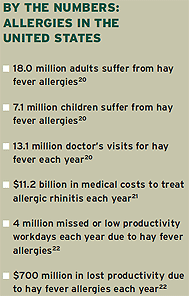
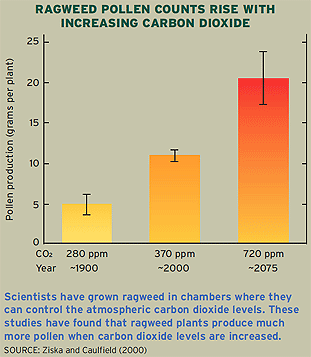
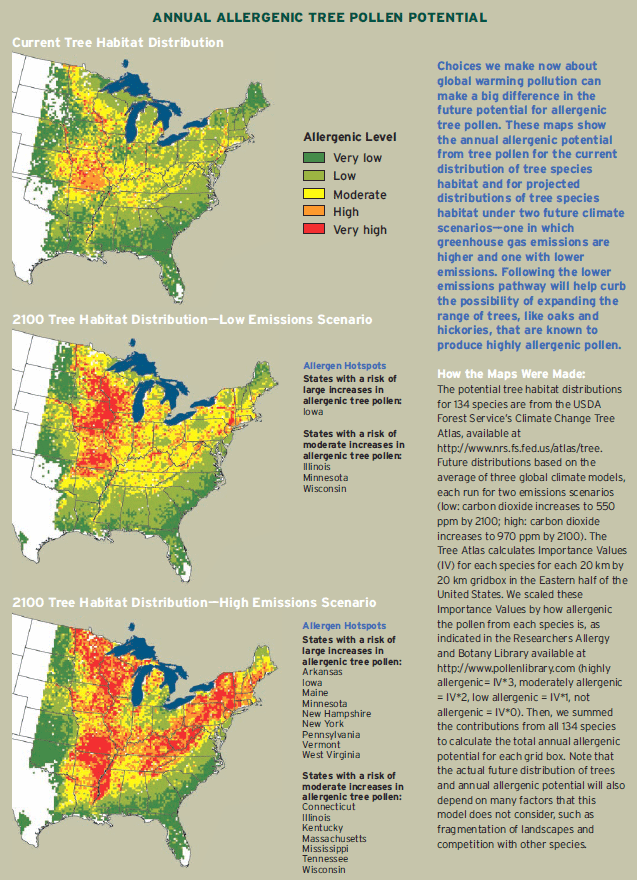
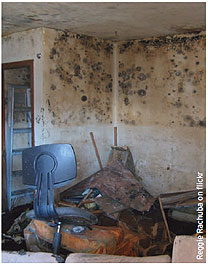
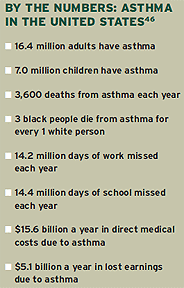
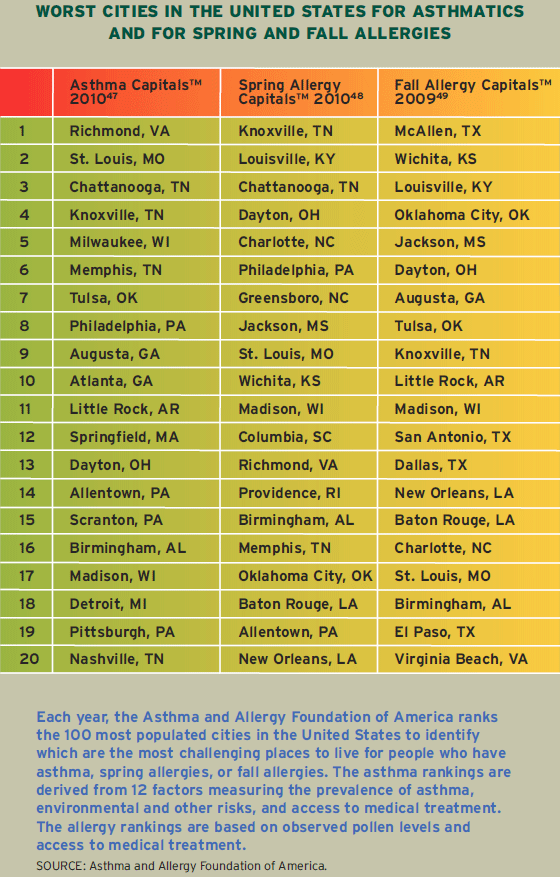
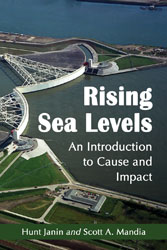

Scott, thanks for a very informative article. As a lifelong allergy & asthma sufferer, I understand how important these kinds of changes can be to people. However, I’m suspicious of the argument that global warming is somehow guaranteed to change the allergen environment for the worse.
Briefly, this is really no different than moving to a different location. If you were to come up here to Calgary, Alberta, you wouldn’t find much oak tree pollen. But you’d have plenty of opportunity to develop allergies to molds, grasses, & birch trees. If you want to wait a few years, we’re busily planting oak trees. If you go to the west coast (Vancouver), you’ll find a different allergen regime (much less mold and grass pollen, more ragweed, alder pollen, ozone and smog. But a much better place to live for me, allergy-wise.
My belief – and it’s only a belief, at this point – is that the allergy regime *for me* will improve with global warming. Unfortunately I’ll be too worried about how my kids are making out in life to pay much attention.
“Climate change is more than just something to sneeze at – it can be deadly for asthmatics!” Seriously, this is the kind of sensationalist statement that the denialists love to use to prove how unrealistic we are. But really, asthmatics are like everybody else – they can learn to adapt to changing conditions. If that means moving to another town, I can deal with that. I’d be happier if we learned to reduce urban pollution faster, but maybe when we stop driving everywhere…
Carry on.
Greg H
May 6, 2010 at 2:38 pm
[…] of the winners is also deadly to many: pollen. As I detailed in Global Warming IS Something to Sneeze At!, debilitating ands costly allergies and deadly asthma are on the increase due to increased CO2 […]
Tom Harris Teaches Heartland Institute Fake Science to Students « Global Warming: Man or Myth?
March 1, 2012 at 10:16 am